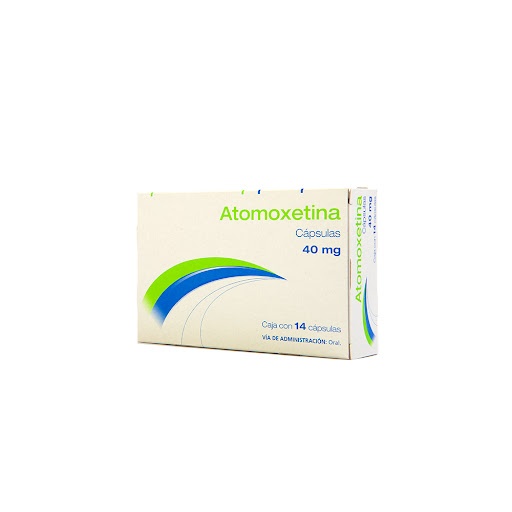

ATOMOXETINA TARBIS 40 mg CÁPSULAS DURAS

Pergunte a um médico sobre a prescrição de ATOMOXETINA TARBIS 40 mg CÁPSULAS DURAS

Como usar ATOMOXETINA TARBIS 40 mg CÁPSULAS DURAS
Introdução
Prospecto: informação para o utilizador
Atomoxetina Tarbis 10 mg cápsulas duras EFG
Atomoxetina Tarbis 18 mg cápsulas duras EFG
Atomoxetina Tarbis 25 mg cápsulas duras EFG
Atomoxetina Tarbis 40 mg cápsulas duras EFG
Atomoxetina Tarbis 60 mg cápsulas duras EFG
Atomoxetina Tarbis 80 mg cápsulas duras EFG
Atomoxetina Tarbis 100 mg cápsulas duras EFG
Leia todo o prospecto detenidamente antes de começar a tomar este medicamento, porque contém informações importantes para si.
- Conserva este prospecto, porque pode ter que o ler novamente.
- Se tiver alguma dúvida, consulte o seu médico ou farmacêutico.
- Este medicamento foi-lhe prescrito apenas para si, e não deve dá-lo a outras pessoas, mesmo que tenham os mesmos sintomas que si, porque pode prejudicá-las.
- Se experimentar efeitos adversos, consulte o seu médico ou farmacêutico, mesmo que se trate de efeitos adversos que não aparecem neste prospecto. Ver secção 4.
Conteúdo do prospecto
- O que é Atomoxetina Tarbis e para que é utilizado
- O que necessita saber antes de começar a tomar Atomoxetina Tarbis
- Como tomar Atomoxetina Tarbis
- Posíveis efeitos adversos
- Conservação de Atomoxetina Tarbis
- Conteúdo do envase e informações adicionais
1. O que é Atomoxetina Tarbis e para que é utilizado
Para que é utilizado
Atomoxetina Tarbis contém atomoxetina e é utilizado no tratamento do transtorno por déficit de atenção com hiperactividade (TDAH). É utilizado
? em crianças a partir dos 6 anos
? em jovens
? em adultos
É utilizado apenas como parte do tratamento completo da doença que requer também tratamentos que não incluem medicamentos, como aconselhamento ou terapia de conduta.
Não é utilizado para o tratamento do TDAH em crianças menores de 6 anos devido a que não se conhece se o fármaco funciona ou se é seguro nesta população.
Em adultos, atomoxetina é usada para o tratamento do TDAH quando os sintomas são muito problemáticos e afetam o trabalho ou vida social e quando teve sintomas da doença quando era criança.
Como funciona
Atomoxetina aumenta a quantidade de noradrenalina no cérebro. Ésta é uma substância química produzida de forma natural e que aumenta a atenção e diminui a impulsividade e hiperactividade nos pacientes com TDAH. Este medicamento foi-lhe prescrito para ajudar a controlar os sintomas do TDAH. Este medicamento não é um estimulante e, portanto, não provoca dependência.
Podem tardar algumas semanas desde que comece o tratamento com o medicamento até que os sintomas melhorem completamente.
Sobre o TDAH
Crianças e jovens com TDAH encontram:
? dificuldade para estar sentados
? dificuldade para concentrar-se
Não é culpa deles que não possam fazer estas coisas. A muitas crianças e jovens isto é difícil. No entanto, aos pacientes com TDAH isto pode causar problemas no dia a dia. Crianças e jovens com TDAH podem ter dificuldade em aprender e fazer os deveres. Têm dificuldade em se comportar bem em casa, na escola ou em outros lugares. O TDAH não afeta a inteligência de uma criança ou de um jovem.
Adultos com TDAH encontram difícil fazer todas as coisas que as crianças também encontram difíceis, no entanto isto pode significar que tenham problemas com:
? trabalho
? relações
? baixa autoestima
? educação
2. O que necessita saber antes de começar a tomar Atomoxetina Tarbis
Não tome Atomoxetina Tarbis:
- se é alérgico à atomoxetina ou a qualquer um dos outros componentes deste medicamento (incluídos na secção 6).
- se tomou nas últimas duas semanas um medicamento dos denominados inibidores da monoaminoxidase (IMAO), por exemplo fenelzina. Os IMAO são utilizados às vezes para a depressão e outros transtornos mentais; tomar atomoxetina junto com um IMAO poderia causar efeitos adversos graves ou constituir uma ameaça para a vida. Assim como deve esperar pelo menos 14 dias após terminar o tratamento com atomoxetina antes de tomar um IMAO.
- se tem uma doença ocular chamada glaucoma de ângulo estreito (aumento da pressão nos olhos).
- se tem problemas graves de coração que podem piorar por um aumento na frequência cardíaca e/ou na pressão sanguínea, o que pode ocorrer com atomoxetina.
- se tem problemas graves nos vasos sanguíneos do seu cérebro, tais como um derrame cerebral, parte de um vaso sanguíneo inflamado e debilitado (aneurisma) ou vasos sanguíneos estreitos ou obstruídos.
- se tem um tumor da sua glândula adrenal (feocromocitoma).
Não tome atomoxetina se lhe aplicar algum dos casos anteriores. Se não estiver seguro, consulte o seu médico ou farmacêutico antes de tomar atomoxetina devido a que atomoxetina pode piorar estes problemas.
Advertências e precauções
Tanto os adultos como as crianças devem ter em conta as seguintes advertências e precauções. Consulte com o seu médico ou farmacêutico antes de começar a tomar atomoxetina se tem:
? ideias ou tentativa de suicídio.
? problemas cardíacos (incluindo defeitos cardíacos) ou uma frequência cardíaca aumentada. Atomoxetina Tarbis pode aumentar a sua frequência cardíaca (pulso). Foram notificados casos de morte súbita em pacientes com defeitos cardíacos.
? a pressão sanguínea elevada. Atomoxetina Tarbis pode aumentar a sua pressão sanguínea.
? a pressão sanguínea baixa. Atomoxetina Tarbis pode causar tonturas ou desmaios em pessoas que tenham a pressão sanguínea baixa.
? problemas com mudanças repentinas na sua pressão sanguínea ou frequência cardíaca.
? doença cardiovascular ou antecedentes de ter sofrido um acidente cerebrovascular.
? problemas de fígado. Pode necessitar de uma dose menor.
? reações psicóticas incluindo alucinações (ouvir vozes ou ver coisas irreais), acreditar coisas que não são verdadeiras ou mostrar-se desconfiado.
? mania (sentir-se exaltado ou sobreexcitado, o que provoca um comportamento incomum) e agitação.
? sentimento agressivo.
? sentimento de antipatia e raiva (hostilidade).
? antecedentes de epilepsia ou tenha sofrido convulsões por alguma outra razão. Atomoxetina poderia produzir um aumento na frequência das convulsões.
? estado de ânimo diferente do habitual (mudanças de humor) ou sentimento de infelicidade.
? espasmos repetidos de difícil controlo de qualquer parte do corpo ou repetição de sons e palavras.
Síndrome serotoninérgicoO síndrome serotoninérgico é uma condição potencialmente mortal que pode ocorrer ao tomar Atomoxetina Tarbis em combinação com alguns outros medicamentos (ver secção 2 “Outros medicamentos e Atomoxetina Tarbis”). Os sinais e sintomas do síndrome serotoninérgico podem incluir uma combinação dos seguintes: confusão, inquietude, falta de coordenação e rigidez, alucinações, coma, ritmo cardíaco acelerado, aumento da temperatura corporal, mudanças rápidas na pressão arterial, suor, rubor, tremores, reflexos exagerados, náuseas, vómitos e diarreia. Comunique-se com um médico ou acuda ao departamento de emergências mais próximo de imediato se acredita que está experimentando síndrome serotoninérgico.
O tratamento com Atomoxetina Tarbis pode fazer com que se sinta agressivo, hostil ou violento, ou que estes sintomas se agravem se já estavam presentes antes do tratamento. Também pode causar mudanças incomuns no comportamento ou no estado de ânimo (incluindo agressões físicas, comportamento ameaçador e pensamentos de fazer mal a outros). Se si ou a sua família e/ou amigos notam alguma destas reações, fale com o seu médico ou farmacêutico de imediato.
Consulte o seu médico ou farmacêutico se tiver algum dos sintomas mencionados anteriormente antes de começar o tratamento, devido a que atomoxetina pode fazer com que estes problemas se agravem. O seu médico quererá fazer um acompanhamento sobre como o medicamento o afeta.
Provas que o seu médico realizará antes de começar a tomar Atomoxetina Tarbis
Estas provas são para decidir se atomoxetina é o medicamento correcto para si.
O seu médico medirá a
? pressão sanguínea e a frequência cardíaca (pulso) antes e durante o tempo que si estiver tomando atomoxetina
? peso e a altura se durante o tempo em que estiver tomando atomoxetina, si for uma criança ou um adolescente
O seu médico perguntará sobre:
? outros medicamentos que si está tomando
? se tem antecedentes familiares de morte súbita
? qualquer outro problema médico (tais como problemas cardíacos) que si ou a sua família possam ter.
É importante que forneça toda a informação que puder. Isto ajudará o seu médico a decidir se atomoxetina é o medicamento correcto para si. O seu médico pode decidir fazer outras provas médicas antes de começar o tratamento com este medicamento.
Outros medicamentos e Atomoxetina Tarbis
Informa o seu médico ou farmacêutico se está tomando, tomou recentemente ou poderia ter que tomar qualquer outro medicamento. Isto inclui os adquiridos sem receita médica. O seu médico decidirá se pode tomar atomoxetina com outros medicamentos e em alguns casos, pode que o seu médico necessite ajustar a dose ou aumentá-la mais lentamente.
Atomoxetina Tarbis pode afectar ou ser afectado por outros medicamentos. Estes incluem:
- Alguns antidepressivos, opioides como o tramadol e medicamentos utilizados para tratar a enxaqueca chamados triptanos. Estes medicamentos podem interagir com Atomoxetina Tarbis e provocar o síndrome serotoninérgico, uma condição potencialmente mortal. (Ver secção 2, Advertências e Precauções, Síndrome Serotoninérgico).
Não tome Atomoxetina com os medicamentos chamados IMAO (inibidores da monoaminoxidase) tomados para a depressão. Ver secção 2 “Não tome Atomoxetina Tarbis”.
Se está tomando outros medicamentos, atomoxetina pode afectar o funcionamento correcto destes ou provocar efeitos adversos. Se si está tomando qualquer dos seguintes medicamentos, verifique com o seu médico ou farmacêutico antes de tomar atomoxetina:
? medicamentos que aumentam a pressão sanguínea ou são utilizados para controlá-la.
? medicamentos tais como antidepressivos, por exemplo imipramina, venlafaxina mirtazapina, fluoxetina e paroxetina.
? alguns remédios para a tos e o resfriado que contenham medicinas que podem afectar a pressão sanguínea. Quando comprar este tipo de produtos, é importante verificar com o seu farmacêutico.
? alguns medicamentos utilizados para tratar transtornos mentais.
? medicamentos que se sabe que aumentam o risco de convulsões.
? alguns medicamentos que fazem com que atomoxetina permaneça no corpo mais tempo do que o normal (tais como quinidina e terbinafina).
? salbutamol (um medicamento para o tratamento da asma) quando é tomado por via oral ou é injetado, pode ter a sensação de que o seu coração se acelera, mas isto não piorará a sua asma.
Os medicamentos descritos a seguir podem aumentar o risco de apresentar um ritmo cardíaco anormal quando se está tomando atomoxetina:
? medicamentos utilizados para controlar o ritmo cardíaco
? medicamentos que alteram o conteúdo de sais do sangue
? medicamentos para a prevenção e o tratamento da malária
? antibióticos (como eritromicina e moxifloxacino)
Se não estiver seguro sobre se os medicamentos que está tomando estão incluídos na lista anterior, consulte com o seu médico ou farmacêutico antes de tomar atomoxetina.
Gravidez e amamentação
Não se sabe se este medicamento pode afectar o feto ou pode passar para o leite materno.
? Este medicamento não deve ser tomado durante a gravidez a não ser que o seu médico lhe indique o contrário.
? Deve evitar tomar este medicamento se está a amamentar ou deixar de amamentar.
Se está grávida ou em período de amamentação, acredita que possa estar grávida ou tem intenção de ficar grávida ou tem intenção de amamentar o seu bebé, consulte o seu médico ou farmacêutico antes de utilizar este medicamento.
Condução e uso de máquinas
Atomoxetina pode produzir-lhe cansaço, sonolência ou tonturas. Tenha cuidado se conduz ou utiliza maquinaria até que saiba como lhe afecta a tomada de atomoxetina. Se se sentir cansado, com sonolência ou tonturas, não deve conduzir ou utilizar maquinaria.
Informação importante sobre o conteúdo das cápsulas
Não abra as cápsulas de atomoxetina porque o conteúdo das cápsulas pode irritar-lhe os olhos. Se o conteúdo das cápsulas entrar em contacto com os olhos, enxágue-os imediatamente com água abundante e consulte o seu médico. Se as mãos ou qualquer outra parte do corpo entrarem em contacto com o conteúdo da cápsula, deve enxaguá-las com água o mais rapidamente possível.
Atomoxetina Tarbis contém sódio
Este medicamento contém menos de 1 mmol de sódio (23 mg) por cápsula; isto é, essencialmente “isento de sódio”.
3. Como tomar Atomoxetina Tarbis
- Siga exactamente as instruções de administração deste medicamento indicadas pelo seu médico ou farmacêutico. Em caso de dúvida, consulte novamente o seu médico ou farmacêutico. Isto será normalmente uma ou duas vezes ao dia (manhã e última hora da tarde ou primeira da noite).
- As crianças não devem tomar este medicamento sem a ajuda de um adulto.
- Se sentir sonolência ou náuseas quando está tomando atomoxetina uma vez ao dia, o seu médico pode mudar a tomada de medicamento para duas vezes ao dia.
- As cápsulas devem ser engolidas inteiras com ou sem alimentos.
- As cápsulas não devem ser abertas e o conteúdo do interior das cápsulas não deve ser sacado de nenhuma outra forma.
- Tomar o medicamento sempre à mesma hora todos os dias pode ajudá-lo a lembrar que deve tomá-lo.
Quanto tomar
Se é uma criança (a partir dos 6 anos) ou um adolescente:
O seu médico indicar-lhe-á a dose de atomoxetina que deve tomar com base no seu peso. Normalmente deve começar com uma dose baixa antes de aumentá-la, com base no seu peso.
- Até 70 kg de peso: começando com uma dose diária total de 0,5 mg por kg de peso durante um mínimo de 7 dias. O seu médico decidirá então se aumenta para a dose habitual de manutenção de 1,2 mg por kg de peso e por dia.
- Mais de 70 kg de peso: começando com uma dose diária total de atomoxetina de 40 mg durante um mínimo de 7 dias. O seu médico decidirá então se aumenta para a dose habitual de manutenção de 80 mg ao dia. A dose máxima diária é de 100 mg.
Adultos
- Deve começar atomoxetina com uma dose diária total de 40 mg durante um mínimo de 7 dias. O seu médico decidirá então se aumenta para a dose habitual de manutenção de 80 mg a 100 mg ao dia. A dose máxima diária é de 100 mg.
Se tiver problemas de fígado, o seu médico pode recomendar uma dose menor.
Se tomar mais Atomoxetina Tarbis do que deve
Em caso de sobredose ou ingestão acidental, consulte imediatamente o seu médico ou farmacêutico ou ligue para o Serviço de Informação Toxicológica, telefone: 91 562 04 20, indicando o medicamento e a quantidade ingerida. Os sintomas comunicados mais comumente após uma sobredose são sintomas gastrointestinais, sonolência, tonturas, tremores e comportamento anormal. Muito raramente, também foi informado do síndrome serotoninérgico, uma condição potencialmente mortal. (Ver secção 2, Advertências e precauções, Síndrome Serotoninérgico).
Se esquecer de tomar Atomoxetina Tarbis
Se esquecer uma dose, tome outra o mais rapidamente possível, mas não tome uma quantidade que ultrapasse a dose diária total em um período de 24 horas. Não tome uma dose dupla para compensar as doses esquecidas.
Se interromper o tratamento com Atomoxetina Tarbis
Se deixar de tomar atomoxetina, normalmente não aparecem efeitos adversos, mas os sintomas do TDAH podem reaparecer. Deve falar com o seu médico antes de interromper o tratamento.
O que fará o seu médico quando estiver em tratamento:
O seu médico fará algumas provas
- Antes de começar, assegurará que atomoxetina é seguro e beneficiará a si.
- Depois de começar, as provas serão feitas pelo menos de 6 em 6 meses, embora possam ser mais frequentes.
As provas também serão realizadas quando a dose for modificada. Estas provas incluirão:
- Medição da altura e do peso em crianças e jovens.
- Medição da pressão sanguínea e da frequência cardíaca.
- Verificar se tem algum problema ou se os efeitos adversos pioraram enquanto está tomando atomoxetina.
Se tiver alguma outra dúvida sobre o uso deste medicamento, pergunte ao seu médico ou farmacêutico.
4. Efeitos adversos possíveis
Assim como todos os medicamentos, este medicamento pode produzir efeitos adversos, embora nem todas as pessoas os sofram. Embora algumas pessoas sofram efeitos adversos, a maioria considera que a atomoxetina ajuda. O seu médico falará sobre estes efeitos adversos.
Alguns efeitos adversos poderiam ser graves. Se apresentar algum dos efeitos descritos a seguir, entre em contato imediatamente com o seu médico.
Pouco frequentes(podem afetar até 1 de cada 100 pessoas)
- sente ou tem um ritmo cardíaco muito rápido, ritmo cardíaco anormal
- pensamento ou sentimento de suicídio
- sentimento agressivo
- sentimento de antipatia e de enfado (hostilidade)
- mudanças de humor
- reação alérgica grave com sintoma de:
- inchaço da face e garganta
- dificuldade para respirar
- urticária (pequenas ronchas vermelhas e com picor na pele)
- convulsões
- sintomas psicóticos incluindo alucinações (tais como ouvir vozes ou ver coisas que não existem), acreditar coisas que não são verdadeiras ou mostrar-se desconfiado.
Crianças e jovens menores de 18 anos têm maior risco de sofrer efeitos adversos tais como:
- pensamento ou sentimento de suicídio (podem afetar até 1 de cada 100 pessoas)
- mudanças de humor (podem afetar até 1 de cada 10 pessoas)
Os adultos têm um risco menor(podem afetar até 1 de cada 1.000 pessoas) de sofrer efeitosadversos tais como:
- convulsões
- sintomas psicóticos incluindo alucinações (tais como ouvir vozes ou ver coisas que não existem), acreditar coisas que não são verdadeiras ou mostrar-se desconfiado
Raros(podem afetar até 1 de cada 1.000 pessoas)
- afetação do fígado
Interrompa o tratamento com atomoxetina e entre em contato imediatamente com o seu médico se aparecer algum dos efeitos adversos seguintes:
- urina escura
- pele e olhos amarelados
- dor ao palpar na parte superior direita do abdômen, justo abaixo das costelas
- sensação de mal-estar (náuseas) sem explicação
- cansaço
- picor
- sensação de começar com um resfriado
Outros efeitos adversos notificados foram os seguintes. Se algum deles piorar, consulte com o seu médico ou farmacêutico.
Efeitos adversos muito frequentes(podem afetar mais de 1 de cada 10 pessoas) | |
CRANÇAS maiores de 6 anos e JOVENS | ADULTOS |
Estes efeitos podem desaparecer passado um tempo na maioria dos pacientes |
|
Efeitos adversos frequentes(podem afetar até 1 de cada 10 pessoas) | |
CRANÇAS maiores de 6 anos e JOVENS | ADULTOS |
|
|
Efeitos adversos pouco frequentes(podem afetar até 1 de cada 100 pessoas) | |
CRANÇAS maiores de 6 anos e JOVENS | ADULTOS |
|
|
Efeitos adversos raros(podem afetar até 1 de cada 1.000 pessoas) | |
CRANÇAS maiores de 6 anos e JOVENS | ADULTOS |
|
|
Frequência desconhecida(não pode ser estimada a partir dos dados disponíveis) |
CRANÇAS e JOVENSmaiores de 6 anos |
? Rangido involuntário dos dentes (bruxismo) |
Efeitos sobre o crescimento
Quando algumas crianças começam a tomar atomoxetina, seu crescimento (peso e altura) é diminuído. No entanto, com um tratamento a longo prazo, as crianças recuperam o peso e a altura adequada à sua faixa etária. O seu médico vigiará a altura e o peso do seu filho. Se o seu filho não cresce ou ganha peso como se espera, o seu médico pode mudar a dose de atomoxetina ou suspender temporariamente o tratamento com atomoxetina.
Comunicação de efeitos adversos
Se experimentar qualquer tipo de efeito adverso, consulte o seu médico ou farmacêutico, mesmo que se trate de possíveis efeitos adversos que não aparecem neste prospecto. Também pode comunicá-los diretamente através do Sistema Espanhol de Farmacovigilância de Medicamentos de Uso Humano: www.notificaRAM.es. Mediante a comunicação de efeitos adversos, você pode contribuir para fornecer mais informações sobre a segurança deste medicamento.
5. Conservação de Atomoxetina Tarbis
Mantenha este medicamento fora da vista e do alcance das crianças.
Não utilize este medicamento após a data de validade que aparece no envase e no blister após a abreviatura “CAD”. A data de validade é o último dia do mês que se indica.
Este medicamento não requer condições especiais de conservação.
Os medicamentos não devem ser jogados nos esgotos nem na lixeira. Deposite os envases e os medicamentos que não precisa no Ponto SIGRE da farmácia. Em caso de dúvida, pergunte ao seu farmacêutico como se livrar dos envases e dos medicamentos que já não precisa. Dessa forma, ajudará a proteger o meio ambiente.
6. Conteúdo do envase e informação adicional
Composição de Atomoxetina Tarbis
O princípio ativo da atomoxetina.
Cada cápsula dura contém hidrocloruro de atomoxetina equivalente a 10 mg de atomoxetina.
Cada cápsula dura contém hidrocloruro de atomoxetina equivalente a 18 mg de atomoxetina.
Cada cápsula dura contém hidrocloruro de atomoxetina equivalente a 25 mg de atomoxetina.
Cada cápsula dura contém hidrocloruro de atomoxetina equivalente a 40 mg de atomoxetina.
Cada cápsula dura contém hidrocloruro de atomoxetina equivalente a 60 mg de atomoxetina.
Cada cápsula dura contém hidrocloruro de atomoxetina equivalente a 80 mg de atomoxetina.
Cada cápsula dura contém hidrocloruro de atomoxetina equivalente a 100 mg de atomoxetina.
Os demais componentes são: amido de milho pregelatinizado, dimeticona
Revestimento da cápsula
Atomoxetina Tarbis 10 mg cápsulas duras EFG
Tampa:Dióxido de titânio, Gelatina, Lauril sulfato de sódio
Corpo:Dióxido de titânio, Gelatina, Lauril sulfato de sódio
Atomoxetina Tarbis 18 mg cápsulas duras EFG
Tampa:Óxido de ferro amarelo, Gelatina, Lauril sulfato de sódio
Corpo:Dióxido de titânio, Gelatina, Lauril sulfato de sódio
Atomoxetina Tarbis 25 mg cápsulas duras EFG
Tampa:Dióxido de titânio, Índigo carmim, Gelatina, Lauril sulfato de sódio
Corpo:Dióxido de titânio, Gelatina, Lauril sulfato de sódio
Atomoxetina Tarbis 40 mg cápsulas duras EFG
Tampa:Óxido de ferro amarelo, Índigo carmim, Gelatina, Lauril sulfato de sódio
Corpo:Dióxido de titânio, Índigo carmim, Gelatina, Lauril sulfato de sódio
Atomoxetina Tarbis 60 mg cápsulas duras EFG
Tampa:Dióxido de titânio, Índigo carmim, Gelatina, Lauril sulfato de sódio
Corpo:Óxido de ferro amarelo, Gelatina, Lauril sulfato de sódio
Atomoxetina Tarbis 80 mg cápsulas duras EFG
Tampa:Óxido de ferro amarelo, Óxido de ferro vermelho, Dióxido de titânio, Gelatina, Lauril sulfato de sódio
Corpo:Dióxido de titânio, Gelatina, Lauril sulfato de sódio.
Atomoxetina Tarbis 100 mg cápsulas duras EFG
Tampa:Óxido de ferro amarelo, Óxido de ferro vermelho, Dióxido de titânio, Gelatina, Lauril sulfato de sódio
Corpo:Óxido de ferro amarelo, Óxido de ferro vermelho, Dióxido de titânio, Gelatina, Lauril sulfato de sódio.
Tinta de impressão (preta)
Goma laca, Óxido de ferro preto, Hidróxido de potássio
Aspecto de Atomoxetina Tarbis e conteúdo do envase
Atomoxetina Tarbis 10 mg cápsulas duras EFG
Cápsulas de gelatina dura de cor branca opaca/branca opaca de tamanho "5" impressas com "I" na tampa e "105" no corpo, recheadas com pó granular de cor branca a esbranquiçada.
Atomoxetina Tarbis 18 mg cápsulas duras EFG
Cápsulas de gelatina dura de cor amarela/branca, opacas, tamanho "4", impressas com "I" na tampa e "106" no corpo, cheias de pó granular de cor branca a esbranquiçada.
Atomoxetina Tarbis 25 mg cápsulas duras EFG
Cápsulas de gelatina dura de cor azul opaca/branca opaca de tamanho "3" impressas com "I" na tampa e "107" no corpo, recheadas com pó granular de cor branca a esbranquiçada.
Atomoxetina Tarbis 40 mg cápsulas duras EFG
Cápsulas de gelatina dura de cor azul opaca/azul opaca de tamanho "2" impressas com "I" na tampa e "108" no corpo, recheadas com um pó granular de cor branca a esbranquiçada.
Atomoxetina Tarbis 60 mg cápsulas duras EFG
Cápsulas de gelatina dura de cor azul opaca/amarela, tamanho "2", impressas com "I" na tampa e "109" no corpo, recheadas de pó granular de cor branca a esbranquiçada.
Atomoxetina Tarbis 80 mg cápsulas duras EFG
Cápsulas de gelatina dura de cor marrom opaca/branca opaca de tamanho "2" impressas com "I" na tampa e "110" no corpo, recheadas com pó granular de cor branca a esbranquiçada.
Atomoxetina Tarbis 100 mg cápsulas duras EFG
Cápsulas de gelatina dura de cor marrom opaca/marrom opaca de tamanho '1' impressas com 'I' na tampa e '111' no corpo, recheadas com pó granular de cor branca a esbranquiçada.
As cápsulas de Atomoxetina Tarbis estão disponíveis em blisteres que contêm 7, 28, 30, 56 e 98 cápsulas duras.
Pode ser que apenas alguns tamanhos de envases sejam comercializados.
Titular da autorização de comercialização
Tarbis Farma S.L.
Gran Vía Carlos III, 94
08028 Barcelona
Espanha
Responsável pela fabricação
Amarox Pharma B.V.
Rouboslaan 32
Voorschoten, 2252TR
Países Baixos
Este medicamento está autorizado nos estados membros do Espaço Econômico Europeu com os seguintes nomes:
Alemanha: Atomoxetin Amarox 10 mg/18 mg/25 mg/40 mg/60 mg/80 mg/100 mg Hartkapseln
Países Baixos: Atomoxetine Amarox 10 mg/18 mg/25 mg/40 mg/60 mg/80 mg/100 mg harde capsules
Espanha: Atomoxetina Tarbis 10 mg/18 mg/25 mg/40 mg/60 mg/80 mg/100 cápsulas duras EFG
Data da última revisão deste prospecto:Novembro 2024
A informação detalhada e atualizada deste medicamento está disponível na página web da Agência Espanhola de Medicamentos e Produtos Sanitários (AEMPS) http://www.aemps.gob.es

Quanto custa o ATOMOXETINA TARBIS 40 mg CÁPSULAS DURAS em Espanha em 2025?
O preço médio do ATOMOXETINA TARBIS 40 mg CÁPSULAS DURAS em novembro de 2025 é de cerca de 29.13 EUR. Os valores podem variar consoante a região, a farmácia e a necessidade de receita. Confirme sempre com uma farmácia local ou fonte online para obter informações atualizadas.
- País de registo
- Preço médio em farmácia29.13 EUR
- Substância ativa
- Requer receita médicaSim
- Fabricante
- Esta informação é apenas para referência e não constitui aconselhamento médico. Consulte sempre um médico antes de tomar qualquer medicamento. A Oladoctor não se responsabiliza por decisões médicas baseadas neste conteúdo.
- Alternativas a ATOMOXETINA TARBIS 40 mg CÁPSULAS DURASForma farmacêutica: CÁPSULA, 10 mgSubstância ativa: atomoxetineFabricante: Laboratorios Rubio S.A.Requer receita médicaForma farmacêutica: CÁPSULA, 100 mgSubstância ativa: atomoxetineFabricante: Laboratorios Rubio S.A.Requer receita médicaForma farmacêutica: CÁPSULA, 18 mgSubstância ativa: atomoxetineFabricante: Laboratorios Rubio S.A.Requer receita médica
Alternativas a ATOMOXETINA TARBIS 40 mg CÁPSULAS DURAS noutros países
As melhores alternativas com o mesmo princípio ativo e efeito terapêutico.
Alternativa a ATOMOXETINA TARBIS 40 mg CÁPSULAS DURAS em Polónia
Alternativa a ATOMOXETINA TARBIS 40 mg CÁPSULAS DURAS em Ukraine
Médicos online para ATOMOXETINA TARBIS 40 mg CÁPSULAS DURAS
Avaliação de posologia, efeitos secundários, interações, contraindicações e renovação da receita de ATOMOXETINA TARBIS 40 mg CÁPSULAS DURAS – sujeita a avaliação médica e regras locais.













